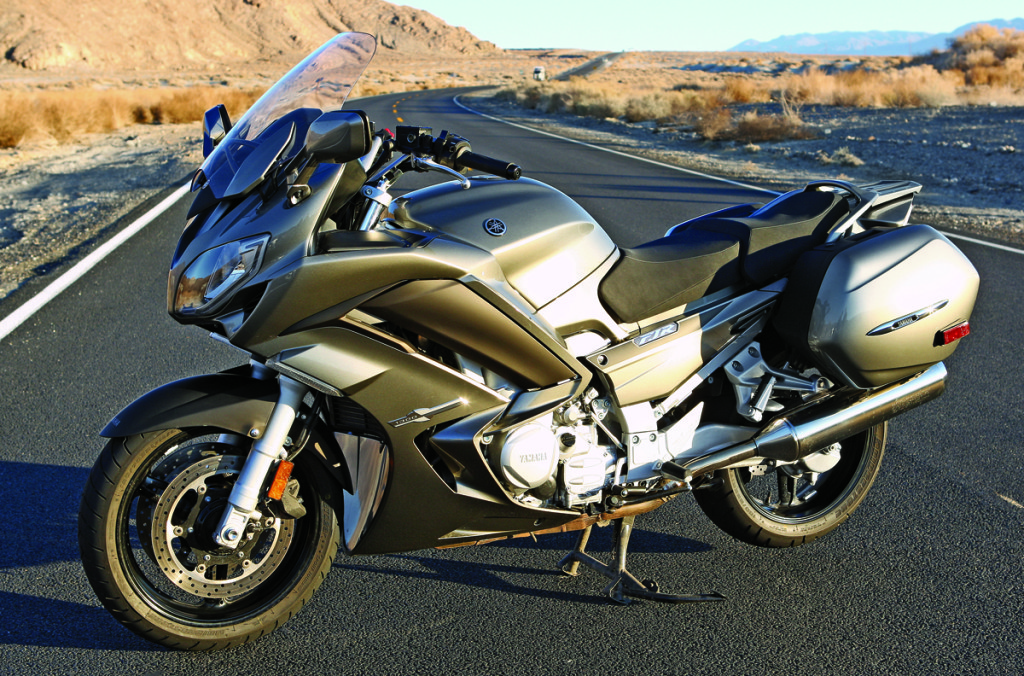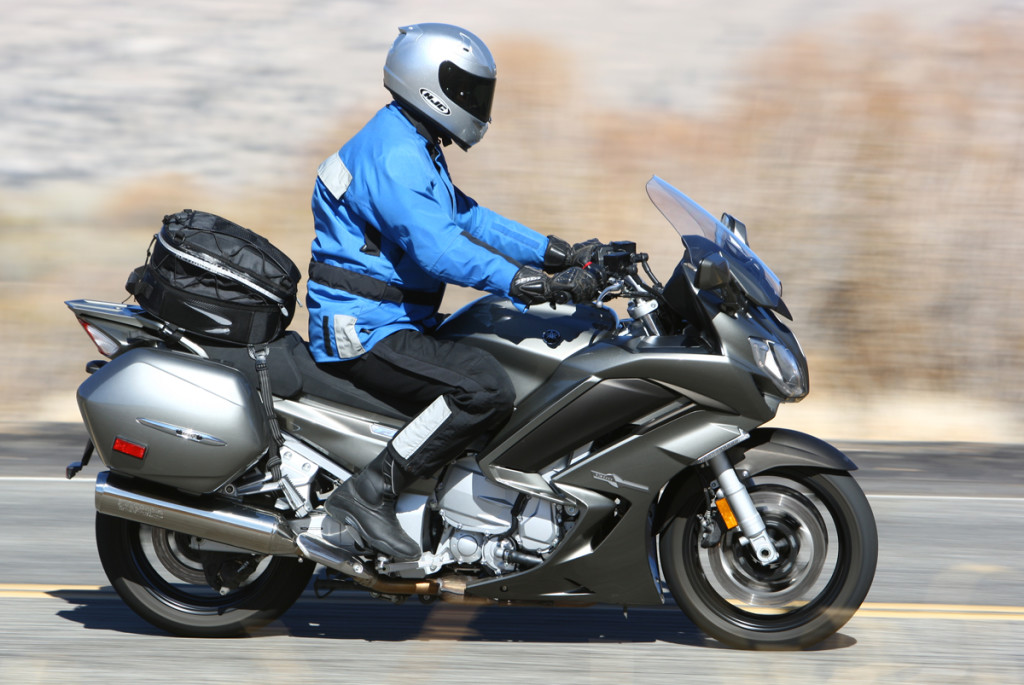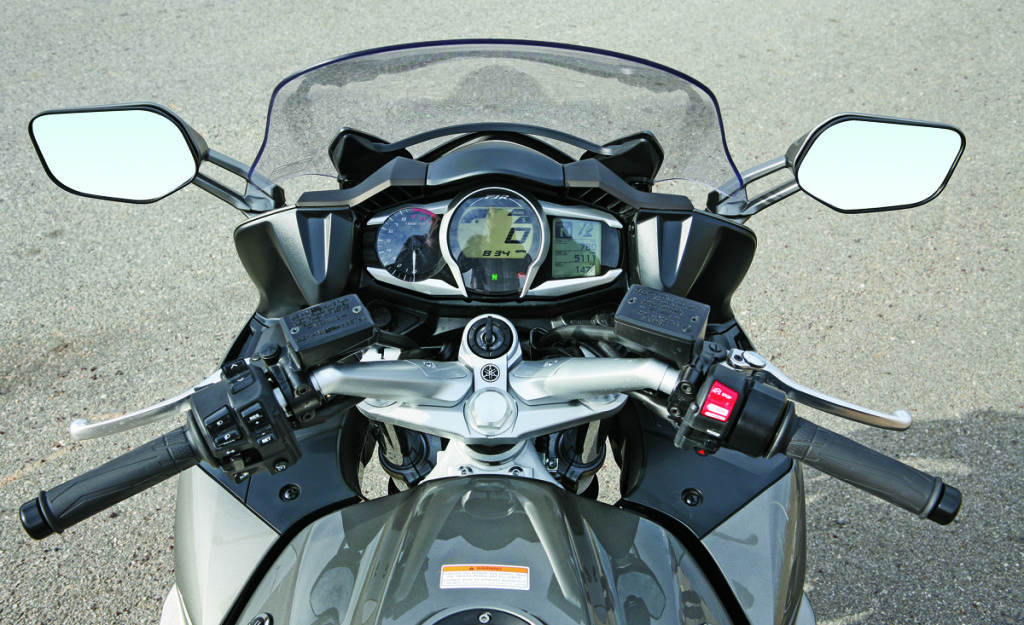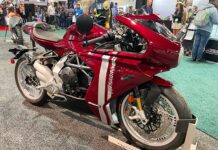
Every bike in this comparison has roots that go back decades, from the BMW R100RT in the late ’70s, to the BMW K100RT, Kawasaki Concours ZG1000 and Yamaha FJ1100 in the ’80s, to the Triumph Trophy 1200 in the early ’90s. Engines, chassis, components, tires, technology and features have improved steadily, resulting in today’s amazing, state-of-the-art sport tourers.

When the Yamaha FJR1300 was introduced for 2003, its curb weight was as light or lighter than the competition, but its liquid-cooled, fuel-injected 1,298cc in-line four cranked out 25-35 more horsepower and 18-35 more lb-ft of torque. With its final drive case adopted from the V-Max muscle cruiser, the new FJR took no prisoners. Performance plus touring prowess—standard hard saddlebags, luggage rack and electric windscreen, a 6.6-gallon fuel capacity and available ABS—earned it Rider’s Motorcycle of the Year award in 2003.
Updates in 2006 and 2008 improved engine heat management, fixed abrupt throttle response and refined the anti-lock braking system. For 2013, improvements to the engine, electronics, transmission, handling, instrumentation and ergonomics have made the FJR a better bike all-around, with a styling refresh to boot (Rider, February 2013 and on ridermagazine.com). But all of the model updates over the past decade have left the basic platform unchanged. We wouldn’t be surprised to see a major overhaul within the next few years.

At $15,890, the Yamaha FJR1300 is the least expensive bike in this test, and as one tester put it, offers the “most bang for the buck.” Riding modes, cruise control, traction control and ABS are all standard, as are heated grips. Though not the lightest bike here (at 663 pounds wet, it’s 37 pounds heavier than the BMW R 1200 RT), the FJR looks and feels the smallest, offering the most sportbike-like riding experience and the least wind protection.
2013 Yamaha FJR1300 Specs
Base Price: $15,890
Warranty: 1 yr., unltd. miles
Website: yamahamotorsports.com
Engine
Type: Liquid-cooled, transverse in-line four
Displacement: 1,298cc
Bore x Stroke: 79.0 x 66.2mm
Compression Ratio: 10.8:1
Valve Train: DOHC, 4 valves per cyl.
Valve Adj. Interval: 26,000 miles
Fuel Delivery: Electronic Fuel Injection w/ YCC-T
Lubrication System: Wet sump, 4.0-qt. cap.
Transmission: 5-speed, hydraulically actuated wet clutch
Final Drive: Shaft, 2.77:1
Electrical
Ignition: Digital TCI
Charging Output: 490 watts @ 5,000 rpm
Battery: 12V 12AH
Chassis
Frame: Aluminum Diamond type twin-spar w/ engine as stressed member & cast aluminum swingarm
Wheelbase: 60.8 in.
Rake/Trail: 26 degrees/4.3 in.
Seat Height: 31.7/32.5 in.
Suspension, Front: 48mm stanchions, fully adj., 5.3-in. travel
Rear: Single shock, adj. for spring preload & rebound damping, 4.9-in. travel
Brakes, Front: Dual discs w/ opposed 4-piston calipers & UBS ABS
Rear: Single disc w/ 2-piston pin-slide caliper & ABS
Wheels, Front: Cast, 3.50 x 17
Rear: Cast, 5.50 x 17
Tires, Front: 120/70-ZR17
Rear: 180/55-ZR17
Wet Weight: 663 lbs.
Load Capacity: 448 lbs.
GVWR: 1,111 lbs.
Performance
Fuel Capacity: 6.6 gals., last 1.3 gals. warning light on
MPG: 86 PON min. (high/avg/low) 48.4/40.8/35.6
Estimated Range: 269 miles
Indicated RPM at 60 MPH: 3,000
This sidebar was published as part of our 2013 Sport-Touring Comparison Test: BMW K1600GT, BMW R1200RT, Kawasaki Concours 14, Triumph Trophy, Yamaha FJR1300.








Don’t know if anyone else has caught this but Yamaha’s website lists the wet weight of the FJR1300 at 637 lbs, while this review has it at 663. If there’s a reason for this difference, I suggest that you mention it in your review.
6 years later, but they list wet weight on the review. Yamaha lists dry weight. So there’s ~30 lbs of oil, gas, and coolant. It is a bit heavy for what it is, given that the RT is a physically larger bike with a much larger fairing.
Motorcycle manufacturers have a long history of understating motorcycle weights, hoping to convince the world that their bikes are lighter than they actually are. Weights used to be quoted as “dry,” which was without gas, oil, coolant, and other fluids, and sometimes excluding the battery. Even these weights used to be mysteriously low, leading to jokes about test bikes having helium-filled tires. These days, most OEMs quote “wet” or curb or ready-to-ride weights, and they seem to be much closer to reality than in the past. In fact, sometimes the wet weights we quote are actually lower than official specs (when Rider tests a motorcycle, it is always weighed with all fluids, a full tank of gas, and, if applicable, as-tested accessories). We don’t have a good reason why the wet weight we quoted for the 2013 Yamaha FJR1300, using the same, calibrated scale that we’ve been using for years, is so much higher than what is quoted on Yamaha’s website. We suspect they were being optimistic.
Thanks for responding to my note about weights. So you normally weigh bikes for your reviews? Most of the time when a reviewer lists motorcycle specifications, the specs match exactly that of the manufacturer. This is why I mentioned the weight difference. I thought this might have been the result of a typo. If not, the difference was enough to at least wonder why it came out that way. Thanks again for this information. From now on, I’ll be a little bit more skeptical with manufacturer’s specs.
I bought my Fjr1300 in October 2001 and kept it for almost 10 years. Great bike but ask any owner from then to now what the bike is missing and they all say: one more gear….. Yamaha listen to your customers please…..
I don’t understand the fascination with more gears, which just equates to more work while riding. Granted, I’ve only been riding for 42 years now, and have owned all types of bikes, but I’ve never once returned home from a trip and said to myself, “Geez, I which I could have shifted more often during those hundreds (or thousands) of miles”. Not once.
Isn’t riding about taking the perfect line, concise throttle control in a curve, proper weight shifting, appropriate braking, etc? If one still feels the need to practice shifting after a million times at it, then go for it. That’s one riding activity that doesn’t add to the experience for me.
If the bike can pull cleanly from zero to well into the triple digits with just five gears, then what’s the problem with that?
To put my comment into better perspective, the last 30+ bikes I’ve owed had 6 cogs, including a BMW K1300S, and I’ve never owned an FJR.
To maybe help you with your 6 speed question, I have owned, sold, and serviced All kinds of motorcycles and have owned more motorcycles than most. am 74 years old and still love going fast.
I really liked the last 2 ST 1300 Hondas with a 5 speed transmissions. have never owned an FJR but my son rides one and we both like it a lot, but on the open road, my 6 speed Concours will tear him up on gas mileage Mostly because of a lot slower turning engine and blow his doors, when shifted down. Enough said, I am seriously looking into trading for an FJR simply for the cruise control and the passenger accommodations.
Amazing that in 42 years of riding you’ve completely missed the point of 6 gears vs. 5 – (hint: it’s not the shifting). It’s about better mileage and lower cruising rpms – 6th can be treated as an overdrive gear – highway only – top speed only – gear. If you are using 6th in and around town, or out on the curves, well, no wonder you think it’s too much work. Just as you mentioned “concise throttle control through a curve” it gives you more concise speed control, because the gear ratios of 1-5 are a little different (or should be). You are welcome to disagree (as I’m sure you will – anyone who’s been doing something for 42 years is pretty set in their thinking), so this response is really for others who come across this.
I’m purchasing a 2015 m/c thinking the kawasaki concourse would have cruise control on the 2015 . Well, Yamaha Fjr in January.
I understand the newest 2016 Yamaha FJR model has the 6th gear so many wanted…
And Triumph stopped making the TROPHY SE in 2017, so no more competition from them (for now, unless they redesign and introduce another model down the rod, and support it better here in the States) in this Sports/Touring niche.
Like the TROPHY, I wish Yamaha would add to the FJR a nice AM/FM/USB/XM Satalitestereo system W/Blue tooth capability to a wireless intercom system like the SENA or Cardo brands with fingertip handlebar controls…
And, how about a better passenger pad on the TOP BOXES which maybe curve to the shape of persons back – wider and taller like some of the aftermarket backrests do, then less desire to buy aftermarket seating with backrests. Maybe a backrest option for the driver too?
The Kawasaki Concours was way to cramped for me (6′-2″) with titanium Stryker brand after-market replacement knees that don’t fully bend like the originals OEM ones did back when healthy, eh! And had to crank my neck up too much to look 12 seconds down the road for hazards for any extended periods of time – too sports like with forwarding leaning for me to “tour” on long rides with in comfort.
The Yamaha FJR seemed nimble and easy to maneuver as its Grandmother – a 1982 Yamaha Seca 400 I still have and rode all around the world (US Army retired helicopter pilot).
This is in answer to sixth gear being needed, ( later model has six) when riding the old fjr you constantly are touching gear lever for another gear as the engine is rather busy even though I knew that seventy mph was exactly 4000 rpm I still used to gently press gear lever up.Basically if the old fjr had six gears you would be reaching for a seventh. My old fjr had 96*000 miles on it when I sold it and it still sounded like new, Amazing bike,I did 56*000 miles and only thing that failed was two indicator bulbs.Other fault with early bike was engine heat ( great in winter) not good in Europe when its very hot.Best all round bike I’ve ever had PS twice in Europe I got 310 miles on a tank averaged 60 mpg,
60mpg?!?!?!?!?! Must have been going downhill with a tail wind. I’ve never seen better than 45mpg (2003 FJR).
My 2013 FJR does around 47 mpg (according to the trip computer); I am in the UK so this is of course based on the Imperial gallon. The US gollon is about 5/6 of an Imperial gallon so this equates to about 39 mpg in the US.
We buy petrol in litres here so just over 10 miles per litre is a good figure to work with.
My only slight complaint is that I would expect about 200 miles before the fuel gauge started flashing but in practice it usually happens sooner than that.
I agree with the previous comment, no way 60 mpg!
I have ridden all of these bikes at some point, and owned a 2008 FJR. I am 6’3″ and 250lbs for reference. I loved my FJR for the most part. The seat was great, power was amazing, wind protection was pretty good, but kind of loud with screen up. Handling was pretty amazing except when fully loaded. Suspension would wallow a bit at high speeds in the twistys. The updated suspension should help. After owning the FJR I can stay that neither the Triumph or RT have enough power to be very interesting. I don’t think the article adequately describes the gap between the RT and Triumph one side and the FJR, Concours, and K1600 on the other. They are in different leagues. Handling on both is pretty amazing on both the RT and Triumph, lighter than the FJR for sure, but I thought they both lacked feedback from the front end compared to FJR. For me they also both felt more cramped with respect to leg room. The pegs were too far forward. The K1600 has GOBS of power and sounds awesome when you rev it out, but steering is way too light in the front end…Low effort, yes, but no feedback whatsoever. It did not give me confidence at speed when riding aggressively. I suppose you could get used to it and develop trust, but it isn’t immediate. The concourse has a bit more top end than the FJR, but it steers heavier. The FJR also feels less top heavy in its weight distribution in my opinion, even though you kind of sit more on the FJR and more in the Concours, if that makes sense. I don’t think the power difference between Concours and FJR is enough to justify it over the benefits of cruise control on the FJR, but I would happily own either and a good deal on the Concours would be hard to pass up.